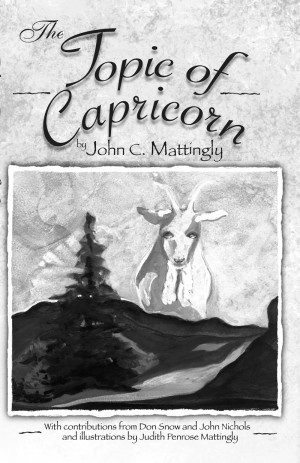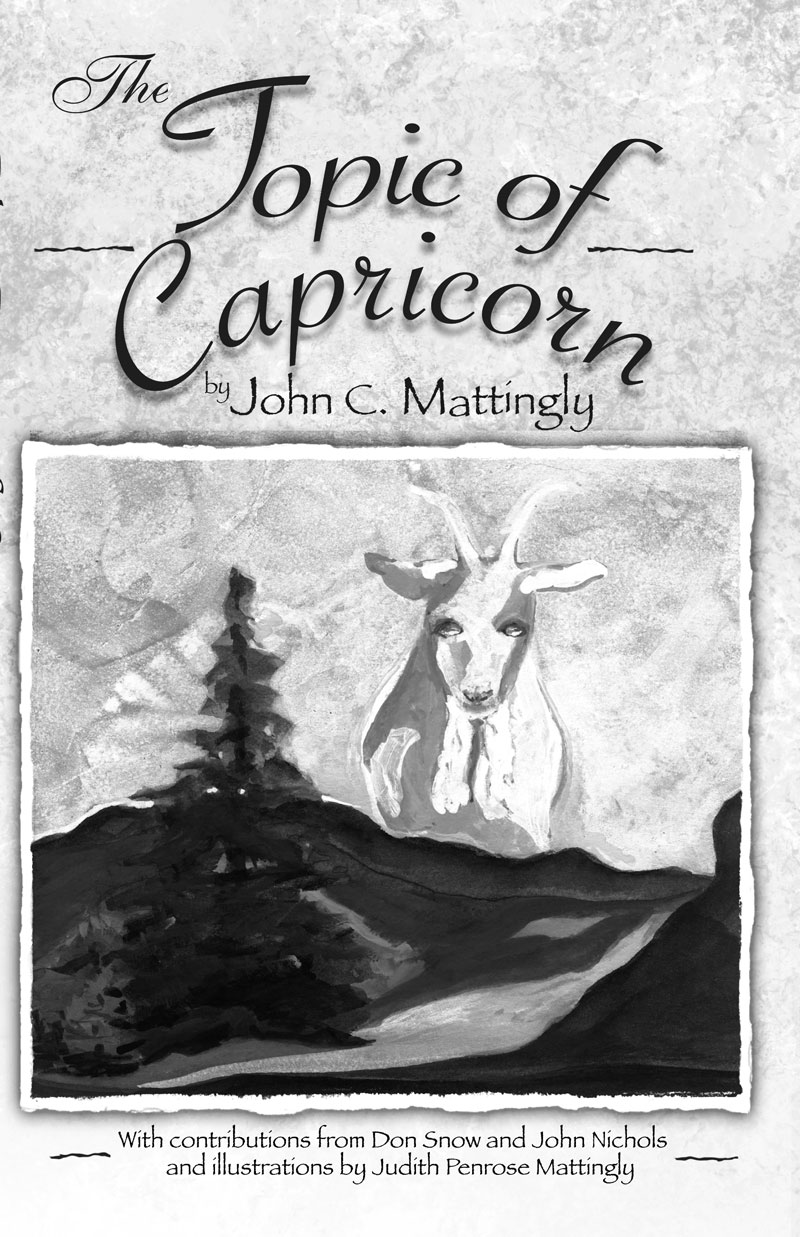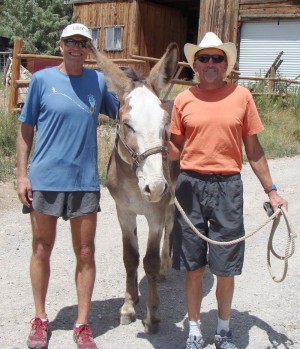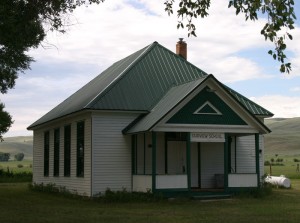Topic of Capricorn
By John C. Mattingly
Illustrations by Judith Penrose Mattingly
Published in 2011 by Mirage Publishing
ISBN 978-0-9710430-4-6
Reviewed by Ed Quillen
There’s an old saying that “Goats can live on nothing and a man can live on goats.” Given that observation and the dismal income level of certain portions of Central Colorado, it’s kind of surprising that we don’t see more goats around these parts.
The critters do have remarkable appetites. A couple of years ago, the Jumpin’ Good Goat Dairy in Buena Vista entered a float in Salida’s boat-race parade. It was a long flat-bed trailer with a corral full of goats. The corral was decorated with plastic flowers. The goats kept jumping to eat the polyethylene blooms.
The only goat-keeper I’ve known didn’t use them for meat or milk. Local artist Michael Boyd kept a couple of pack goats. I thought he was shining me on when he told me about them, but he showed me a couple of issues of a little magazine called something like Pack Goat Quarterly, and invited me to come on a hike sometime when he was exercising his goats, which “could climb anything, including trees.” I never got around to it before he moved to Pueblo, alas.
Goats, which must have been among humankind’s first domesticated animals, also hold a religious significance, as in old-time blood sacrifices and in “separating the sheep from the goats.”
That should give you some idea of how much lore can be extracted from the humble goat, and John Mattingly, an excellent story-teller, gives us plenty more goat lore in this 96-page collection of capricious tales. Some of them might be familiar to Colorado Central readers; others first appeared in The Fence Post, an agricultural publication.
Almost always, there’s an amusing goat anecdote and often a twist at the end of each short chapter, and they’re fun to read, especially if you can take them one or two at a time (does your bathroom need a book?).
And John concludes with some interesting suggestions. After noting that Herbert Hoover promised “a chicken in every pot” when running for president in 1928, “Today, one can imagine a slogan crafted for the modern age: ‘a goat in every yard, a computer in every pocket.’
“A goat in every yard would reduce the noise of lawn mowers and give every American family a chance at good, clean, organic milk, meat, cheese, yogurt, and mohair. What a bargain. Coupled with their Blackberrys …”
My first response to this proposal was that John had gone off the deep end, as goats can be hell on a yard. But then I realized that we already have the damn deer who can be just as destructive, and we’d get all those goat products John listed, plus a lot of entertainment, for goats must be the most amusing of livestock (if they’re not, they’re right behind donkeys). And this book is darn near as entertaining as a flock of goats.
Helen Ring Robinson: Colorado Senator and Suffragist
By Pat Pascoe
University Press of Colorado
2011 ISBN-978-1-60732-146-0 $34.95
Reviewed by Virginia McConnell Simmons
This year marks the 100th anniversary of the election of the first woman to the Colorado State Senate. Appropriately, Pat Pascoe, a former member of that chamber in 1989-2001, has authored this biography of a person who helped crack the glass ceiling, or the gilded dome if you will, on Denver’s Capitol Hill.
Pascoe presents biographical information about her subject from childhood in modest circumstances in the industrial Northeast to teaching in public and private schools, even briefly at Colorado College. She retired from teaching in Denver when she was about 40 years old to marry a widower and to become the stepmother of his small child, although home duties and domestic bliss do not appear paramount in her life. She soon turned her energies to writing and lecturing on various cultural topics and to becoming a leader in Denver’s women’s clubs and in the progressive reform movement and in promoting women’s suffrage. Written accounts and a few formal portraits reveal a composed individual with little interest in high fashion, but the thrust of Helen Ring Robinson’s jaw speaks volumes.
 Women had received the right to vote in Colorado in 1893, and in the following year three women had been elected to the state’s house of representatives. (Wyoming enfranchised women before Colorado, and a woman was elected state senator in Utah.) The first woman in the Colorado State Senate, Helen Ring Robinson, took office in 1913. During her term, she would become the only state senator in the country and a figurehead for the suffrage movement. With her ability as a guest speaker, she made appearances at home and around the nation. These have left tantalizing tidbits for her biographer, like an association with Margaret “Unsinkable Molly” Brown and a visit to Newport, Rhode Island.
Women had received the right to vote in Colorado in 1893, and in the following year three women had been elected to the state’s house of representatives. (Wyoming enfranchised women before Colorado, and a woman was elected state senator in Utah.) The first woman in the Colorado State Senate, Helen Ring Robinson, took office in 1913. During her term, she would become the only state senator in the country and a figurehead for the suffrage movement. With her ability as a guest speaker, she made appearances at home and around the nation. These have left tantalizing tidbits for her biographer, like an association with Margaret “Unsinkable Molly” Brown and a visit to Newport, Rhode Island.
Robinson served one four-year term. As Pasco explains, at that time Colorado’s senate normally met only in odd-numbered years, although a special session also was held in 1914, to deal with expenses of the National Guard during the events at Ludlow. With conservative candidates winning in the vote in 1916, Robinson lost reelection.
In the state senate, among Robinson’s special concerns were bills pertaining to women, education, minimum wage for men, child welfare, institutional care for the mentally ill, public utilities, home rule, and a campaign to allow women to serve on juries. Readers will find detailed information about processes and events there during Robinson’s tenure, due to Pascoe’s interest and knowledge as a former state senator herself.
Pascoe provides detailed descriptions of the activities of Robinson and other women during the United Mine Workers’ strike that began in September 1913. The Ludlow Massacre in April 1914 consumed her attention. At that time, in order to force the indecisive Governor Elias Ammons to call in federal troops, 1,000 women held what might be called the first sit-in by women in the state capitol, and Pascoe describes this event in minute detail.
Following Robinson’s time in the state senate, she served on the State Industrial Commission and pushed the national women suffrage movement, which brought the vote in federal elections to women with the 19th Amendment. (Pascoe’s meager mention of this noteworthy event suggests a need to explore the life and times from a wider perspective.) Robinson also had been active in national politics as a campaigner for Woodrow Wilson. As soon as the country entered World War I, she abandoned her earlier pacifism and threw her passionate energy, no longer encumbered by the presence of husband and stepchild, into war projects such as Liberty Bond drives. Her health suffered from these activities, it is said, and contributed to her death in 1923.
In a closing chapter, Pascoe adds thumbnail accounts of several women who later held elected office in Colorado. The volume is replete with endnotes and bibliography which will make it a useful resource on the history of the early twentieth century in Colorado. The extensive citations from articles in contemporary newspapers and periodicals will be helpful for students in political and women’s studies.




